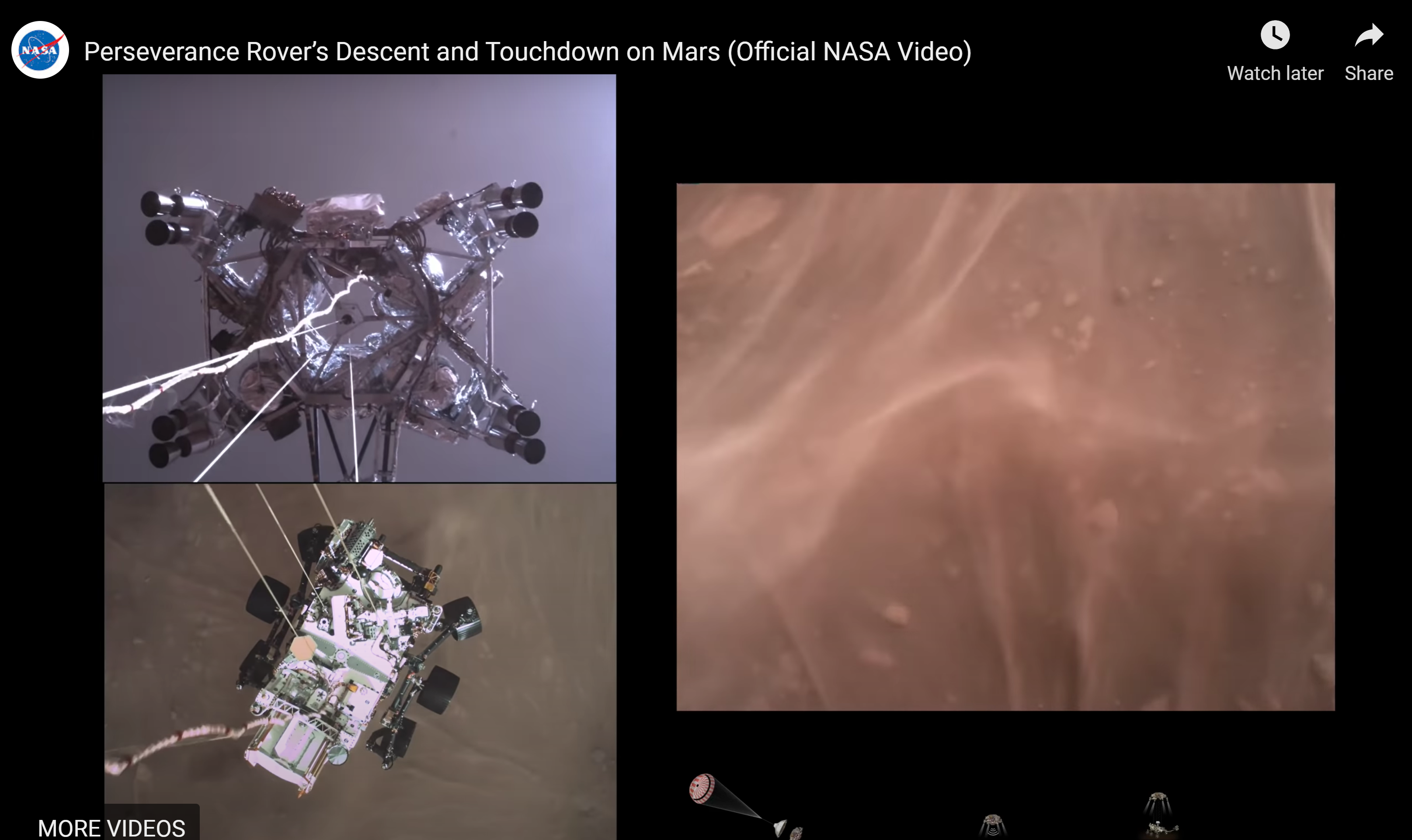
For SpaceUpClose.com & RocketSTEM
CAPE CANAVERAL, FL – NASA released breathtaking 1st of its kind high definition video and audio captured from the dramatic descent and touchdown of the Perseverance Mars Rover that gives one a ‘You Are There’ front row seat to the exciting landing events unfolding in real time on the Red Planet on Feb. 18.
The never-before-seen type of descent and landing video on another captured by several ‘ruggedized’ up looking and down looking cameras installed on the Red Planet rover and descent stage was compiled and spliced into a real time composition of the Feb. 18 live landing coverage from mission control at NASA’s Jet Propulsion Laboratory (JPL) and presented by the science and engineering team leading the mission at a media briefing held today, Feb 22.
For the first time ever humanity can experience the sights and sounds of what it look like during the ‘7 Minutes of Terror’ and Entry, Descent and Landing (EDL) phase on Mars with you as a passenger along for the rousing ride down to the Red Planet’s surface at Jezero Crater and survive to carry out our mission of Exploration and Discovery
“Your front-row seat to my Mars landing is here. Watch how we did it,” the Perseverance rover tweeted.
Your front-row seat to my Mars landing is here. Watch how we did it.#CountdownToMars pic.twitter.com/Avv13dSVmQ
— NASA's Perseverance Mars Rover (@NASAPersevere) February 22, 2021
Watch the new NASA JPL landing video on YouTube here:
Video Caption: NASA’s Mars 2020 Perseverance mission captured thrilling footage of its rover landing in Mars’ Jezero Crater on Feb. 18, 2021. The real footage in this video was captured by several cameras that are part of the rover’s entry, descent, and landing suite. The views include a camera looking down from the spacecraft’s descent stage (a kind of rocket-powered jet pack that helps fly the rover to its landing site), a camera on the rover looking up at the descent stage, a camera on the top of the aeroshell (a capsule protecting the rover) looking up at that parachute, and a camera on the bottom of the rover looking down at the Martian surface. The audio embedded in the video comes from the mission control call-outs during entry, descent, and landing. Credits: NASA/JPL-Caltech
Perseverance also transmitted back her first 360 degree panoramic view of the Mars rover landing site in images taken on Feb. 20, 2021, by the Navigation Cameras, or Navcams, aboard the rover and was stitched together by the team from six individual images after they were sent back to Earth.

In addition to the landing video Perseverance also captured and transmitted sound from the surface of Mars – in the form of winds and the gentle whirl of mechanical movements aboard the rover.
Unfortunately, the EDL microphone did not work during the descent phase.
Listen to the post landing audio in this excerpt from the media briefing
Video caption: NASA’s Perseverance rover’s microphone captured the sound of Martian wind. — Watch the Perseverance rover land on Mars in this epic first-of-its-kind video. Credit: NASA/JPL-Caltech
Here’s more ‘Sounds from Mars’
“Now that you’ve seen Mars, hear it. Grab some headphones and listen to the first sounds captured by one of my microphones,’ as tweeted by Perseverance.
Now that you’ve seen Mars, hear it. Grab some headphones and listen to the first sounds captured by one of my microphones. 🎧https://t.co/JswvAWC2IP#CountdownToMars
— NASA's Perseverance Mars Rover (@NASAPersevere) February 22, 2021
“For those who wonder how you land on Mars – or why it is so difficult – or how cool it would be to do so – you need look no further,” said acting NASA Administrator Steve Jurczyk.
“Perseverance is just getting started, and already has provided some of the most iconic visuals in space exploration history. It reinforces the remarkable level of engineering and precision that is required to build and fly a vehicle to the Red Planet.”
The objective of Perseverance is to carry out an astrobiology mission in search for signs of ancient life in the rocks and soil that may contain preserved biosignatures of microbial organisms in the dried out river delta at Jezero Crater where liquid water once flowed more than 3 billion years ago.
The prime rocks are stromatolites which main consist of sedimentary layers on fossilized mats of microorganisms deposited billions of years ago.
The six-wheeled 1-ton rover is the most sophisticated and advanced ever sent to explore the surface of Mars and will also characterize its geology and climate with a suite of seven state of the art science instruments.
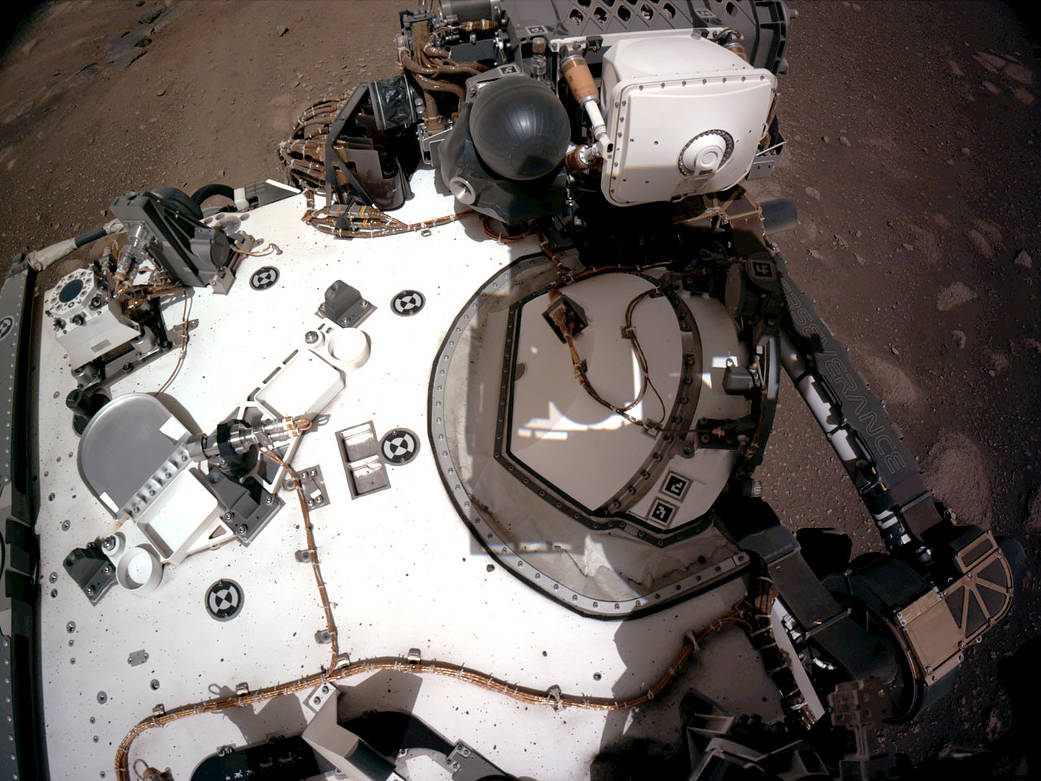
Perseverance counts as first leg of a truly ground breaking astrobiology expedition aimed at collecting and caching dozens of pristine soil and rock samples that will be returned to Earth a decade from now in search of tell-tale signs of past life and eventually pave the way for human exploration of the Red Planet in the late 2030s.
“New video from NASA’s Mars 2020 Perseverance rover chronicles major milestones during the final minutes of its entry, descent, and landing (EDL) on the Red Planet on Feb. 18 as the spacecraft plummeted, parachuted, and rocketed toward the surface of Mars. A microphone on the rover also has provided the first audio recording of sounds from Mars,” said the team at the media briefing.
From the moment of the violent inflation of the 70-foot diameter supersonic parachute inflation, the up looking camera system starts with the unfurling of the cord and parachute deploy with a mortar at 100 mph in 0.7 seconds while moving at over 1000 mph, said JPL Mars Perseverance EDL lead Al Chen.
“It was a textbook inflation with no tangling of the lines,” said Chen.
Perseverance supersonic parachute is the most massive one ever sent to another world.
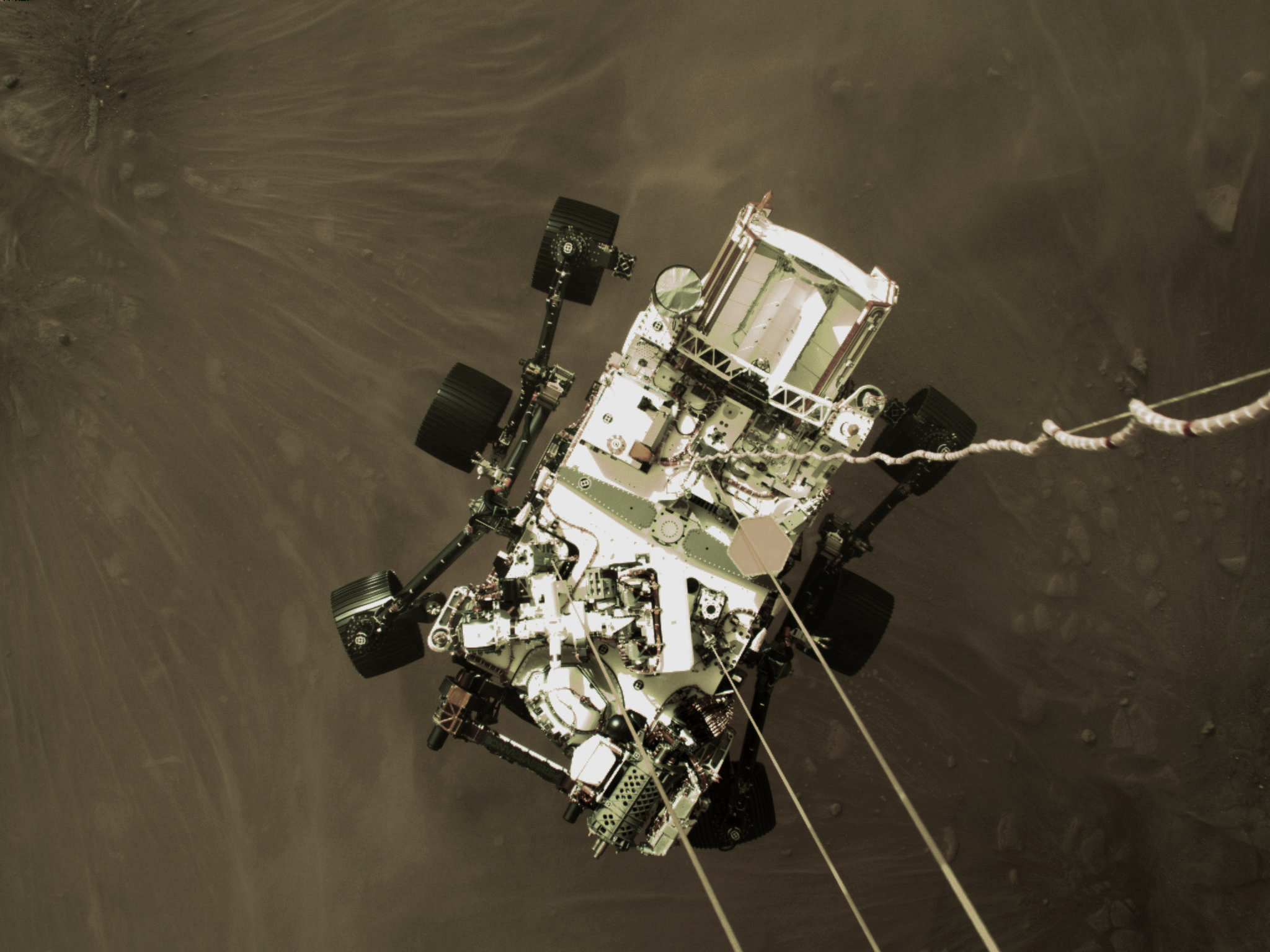
The video covers the entirety of the descent process, showing some of the rover’s intense ride to Mars’ Jezero Crater starting with footage from high-definition cameras aboard the spacecraft at 7 miles (11 kilometers) above the surface and ends with the rover’s touchdown in the crater.
“This video of Perseverance’s descent is the closest you can get to landing on Mars without putting on a pressure suit,” said Thomas Zurbuchen, NASA associate administrator for science.
“It should become mandatory viewing for young women and men who not only want to explore other worlds and build the spacecraft that will take them there, but also want to be part of the diverse teams achieving all the audacious goals in our future.”
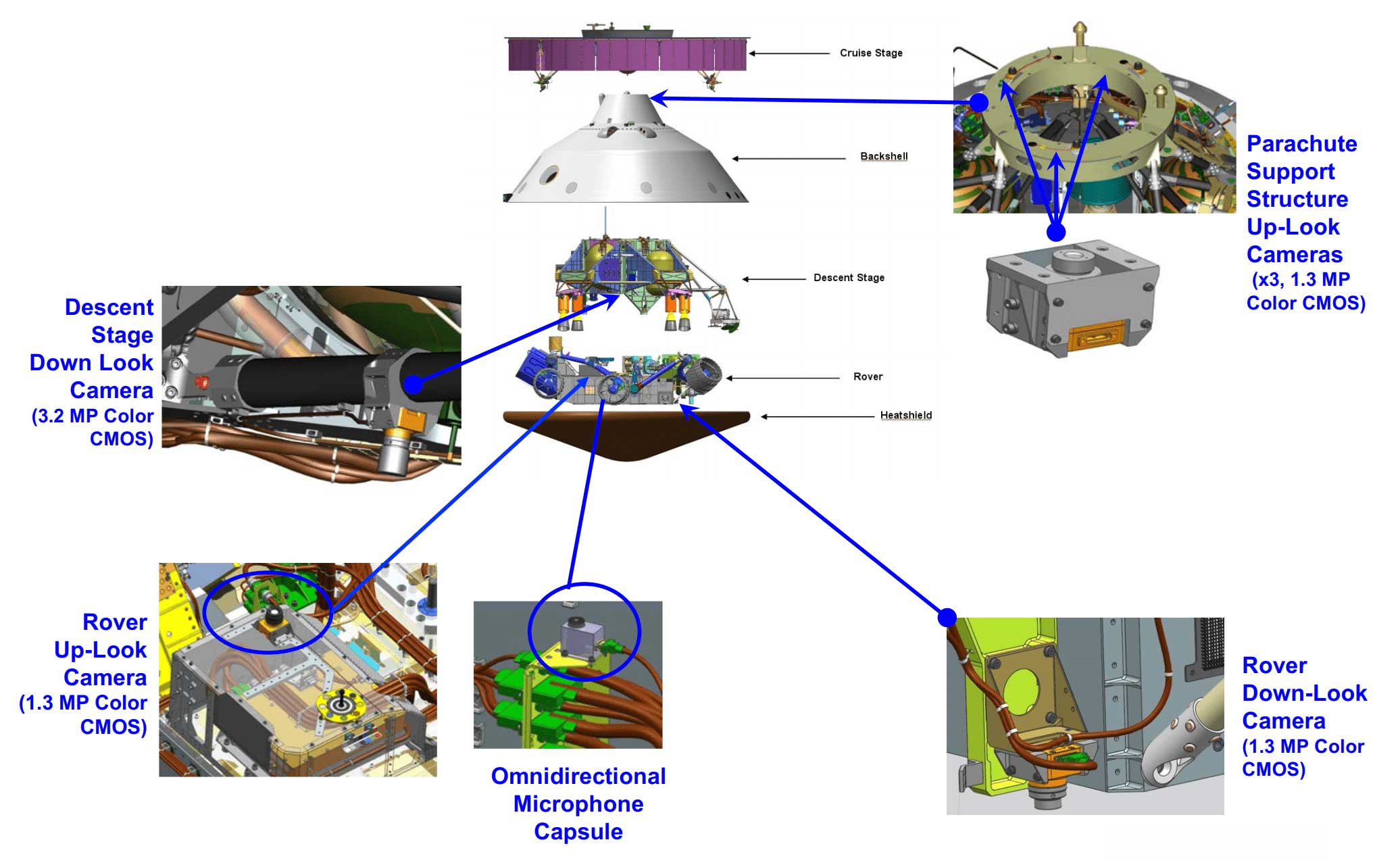
“Now we finally have a front-row view to what we call ‘the seven minutes of terror’ while landing on Mars,” said Michael Watkins, director of NASA’s Jet Propulsion Laboratory in Southern California, which manages the mission for the agency.
“From the explosive opening of the parachute to the landing rockets’ plume sending dust and debris flying at touchdown, it’s absolutely awe-inspiring.”
The team also released a new high resolution image of the NASA’s Perseverance Rover landing taken from Mars orbit the day after landing on Feb 19, 2021 by the High Resolution Imaging Experiment (HiRISE) camera aboard NASA’s Mars Reconnaissance Orbiter (MRO) that shows the many parts of the Mars 2020 mission landing system that got the rover safely on the ground.
The annotated version below points out the locations of the parachute and back shell, the descent stage, the Perseverance rover, and the heat shield. Each inset shows an area about 650 feet (200 meters) across.
The rover itself sits at the center of a blast pattern created by the hovering descent stage that lowered it there using the sky crane maneuver on Feb 18, 2021 at 3:55 p.m. ET.
The descent stage flew off ion a northeasterly direction to crash at a safe distance, creating a V-shaped debris pattern that points back toward the rover. Earlier in the landing sequence, Perseverance jettisoned its heat shield and parachute, which can be seen on the surface in the separate locations illustrated.
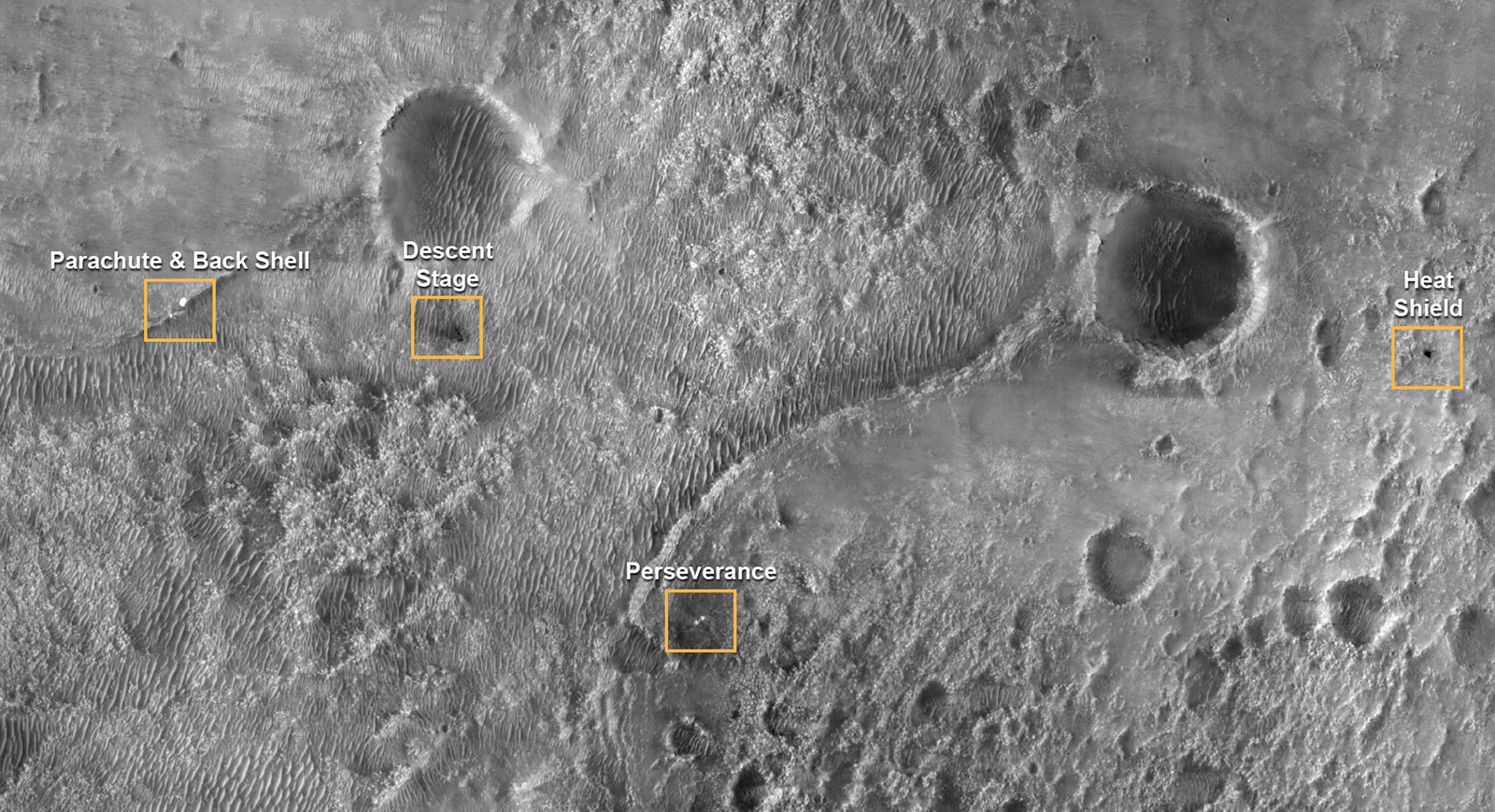
The team was also able to raise the remote sensing mast (RSM) over the weekend
The mast is equipped with the hi resolution navcam as well as the zoomable Mastcam-Z imager and the Supercam imaging and spectroscopic instrument equipped with a laser.
The navcams captured the first 360 degree panorama of the landing site which the rover drivers and team will use to plot the route Perseverance will rove across Jezero to the dried out river delta.
Watch our live and complete ‘Stay Curious’ with live Perseverance landing commentary today Feb 18, 2021 as well as earlier programs on Mars Mania on Feb 12 and Dec 14 and Dec. 30 , 2020 shows on many space topics including Mars Perseverance, Artemis and human spaceflight.
https://www.facebook.com/175507880819/videos/752176242375043
https://www.facebook.com/175507880819/videos/3246699658764085
https://www.facebook.com/175507880819/videos/226784775573274
https://www.facebook.com/175507880819/videos/775199953071117
Watch Ken’s continuing reports about Mars 2020 Perseverance and Curiosity rovers, Artemis and NASA missions, SpaceX, Starlink, Commercial Crew and Starliner and Crew Dragon and onsite for live reporting of upcoming and recent SpaceX and ULA launches including Crew 1 & 2, Demo-2, ISS, X-37B, Solar Orbiter, NRO spysats and national security missions and more at the Kennedy Space Center and Cape Canaveral Space Force Station.
Stay tuned here for Ken’s continuing Earth and Planetary science and human spaceflight news: www.kenkremer.com –www.spaceupclose.com – twitter @ken_kremer – email: ken at kenkremer.com
Dr. Kremer is a research scientist and journalist based in the KSC area, active in outreach and interviewed regularly on TV and radio about space topics.
………….
Ken’s photos are for sale and he is available for lectures and outreach events
Ken has created hundreds of widely published Mars rover mosaics and lectures also about NASA’s Mars rovers
Please consider supporting Ken’s work by donating at Patreon:
https://www.patreon.com/kenkremer
x



